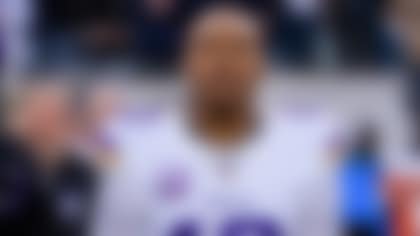On a Friday afternoon in 2007, Carolina Panthers linebacker Jon Beason was two games away from wrapping up a solid first season. He felt good about the product he'd put on the field, quietly going about his business in the way he believed rookies should.
His coach, John Fox, took notice all along, but he also saw something more. So he approached Beason with a request: Talk to the team. Give a speech the night before the game. Accept an honor generally reserved for veterans.
"Here I am as a rookie, we're getting ready to play the Cowboys, and Coach Fox calls on me to speak," Beason said. "I can remember it like it was yesterday. Before then, people saw me as a good player, but nobody really knew me. That's when I arrived.

"From that day forward, I think the coaches and (my) peers had a newfound respect."
That's how it happened for Beason, how his rise to the respected role of team captain occurred. Pretty natural, right? Solid play leads to respect on the field. An inspiring speech leads to respect off it. Teammates and coaches all recognize something special. And voila! A magic "C" appears embroidered on a jersey.
But what happens next? Where do the responsibilities of team captains -- as voted on by players across the league this week -- really begin and end? Forget about finding an exact set of captains' guidelines. Subjectivity is as much a part of discovering a captain as it is of serving as one.
Captains, choir boys and renegades
Take Denver Broncos cornerback Champ Bailey, for instance. Bailey isn't one for speeches, but he might be among the league's most exceptional leaders.
"In any given locker room, you have guys who can be very loud but not say a whole lot," Bailey said. "You also have guys who speak up when they need to. I hear a lot of people talking, but you don't get a lot of info. Lead by example -- that's the way that has worked for me."
When the NFL implemented a program in 2007 that allowed teams to designate up to six players to wear a "C" on their jerseys, Bailey already had been named to seven Pro Bowls. His play on the field made him a natural candidate. So what is his role as a captain in the locker room, particularly as a quiet guy?
Bailey relayed a story from a recent training camp.
"We'd reached a point where guys were very beat up, and we had another padded practice scheduled for that day," he said. "So some of the larger guys approached me to say they really needed a break. They told me they'd go hard tomorrow, but they just needed the break that day.
"So I took the concerns to the coach. You can't take every concern to him, but if it's the appropriate time to do something, he'll do it."
The coach relented. Just as Beason's inspiring speech vaulted him into the good graces of his teammates, Bailey's rational perspective did the same. The one quality that almost all captains share is that they're solid players. But that's actually among the more overrated credentials of a true leader.
Heck, just look at what happened to the New York Jets last year. Wide receiver Santonio Holmes was named a captain -- getting the honorary "C" treatment -- only to become the team's most disruptive force by the season's end. Not only did Holmes fail as a leader, he essentially was an embarrassment to the title.
"Just because you're a good player, it doesn't mean you're a captain," said former NFL quarterback Chad Pennington, a captain for both the Jets and the Miami Dolphins. "Some guys just don't handle that role well. They're the type of people that have to be so focused on themselves that they can't take focus off of that and put it on the team. That's just not how they operate.
"And I don't think it's a good thing or a bad thing -- everybody has to find their niche."
It's perfectly fine to have those types of players, Pennington said. In fact, every solid roster generally does. That's one of the reasons finding great leaders is as essential as finding great players. By insulating talented-but-needy athletes with an effective leader, teams can achieve a rare type of success. (Think Tom Brady and Randy Moss.)
So Pennington wonders why the Dolphins were so quick to give up on Brandon Marshall. That situation might have shed as much light on Miami's lack of a true offensive captain as it did on Marshall's divisive nature.
"Those talented guys, they're very high strung," Pennington said. "They're wired similar. They all have a couple issues you've got to work through, and if you're able to communicate with them and work them through it, you can handle it.
"They've been taken advantage of in their lives because of their athletic ability, so they don't trust a lot of people. So if you're able to win their trust, and show that you have their back, and they can be themselves around you, it will work."
The type of player who is capable of doing this is a leader of the finest kind, someone who can get even the most difficult personalities to follow him.
"That's the beauty of being a team," Pennington said. "You can't have too many choir boys. You need to have some renegades. Football ain't for the well adjusted. We all have a screw loose. That's why we play. But you put it all together -- when you have captains who understand that -- it's a beautiful thing."
'A true captain appoints himself'
That's essentially the very reason that the NFL decided to celebrate this type of leadership five years ago, when a six-member player advisory board recommended the idea of designating the "C" for the jersey. Those captains who get voted to the role multiple times also get one of the four stars under the "C" filled with gold.
Teams are not required to designate captains, but many have adopted the tradition in some format, whether by allowing players to vote for captains or simply having the coaching staff anoint them. Some teams also choose captains on a weekly basis, avoiding the "C" patch altogether. The Green Bay Packers are one of those teams, which is why you won't see guys like Aaron Rodgers or Donald Driver sporting that letter, despite the obvious leadership roles they fill.
"We feel like our entire team is filled with leaders," Driver said. "We don't need to have that one guy who has to speak up all the time. We have 53 captains, day in and day out."
At least, that's the explanation players are given by coach Mike McCarthy, and it's an attitude the team attempts to embrace. But there is undoubtedly a role for a unique leader on every team, even if it is more critical at certain times than others. And even if it doesn't require a "C" on the jersey.
"The 'C' is just recognition," said Bailey, who was a team captain long before the league started recognizing the role with a patch. "But a true captain appoints himself. If you do your job for a long time, somebody is going to vote you a captain at some point. That's a great honor, but we all have a job to do."
Perhaps nowhere in the NFL will the role of a captain be as important as it is this season for the New Orleans Saints. Quarterback Drew Brees' leadership might be the biggest reason that coach Sean Payton's season-long suspension hasn't crippled the team. Brees is among the most distinguished captains in the NFL, and he shows it in several ways, from leading pregame chants to leading by example.
"It takes a true human being to be able to step up and lead -- not just a team but an entire organization," Driver said. "I don't know if Drew wants to put that much pressure on himself, but he's probably among the few willing to do just that."
The answer to that question -- whether someone like Brees is willing to handle such an enormous task -- is one that sheds the most light on this role. Often, a captain sees leading a team as more than simply his responsibility. He sees it as the ultimate challenge.
"It's something to overcome again," Beason said about Brees' situation. "It's like that new goal. (Jonathan) Vilma is gone. The coach is gone. All these guys are suspended. So he's going to try to do more. For him, he won't say it openly, but I think he's kind of grateful for pressure."
To 'C' is to believe
Whether a captain must carry an entire organization on his back or simply quell the occasional locker-room drama, some players would argue there's no one more important to a team's ultimate success.
And if you ask each of them -- from Beason to Bailey to Brees -- they'll all point to captains who came before them as their inspiration. For Bailey, it was Darrell Green, Brian Dawkins and John Lynch. For Beason, it was Dan Morgan.
No doubt, this is a fraternity of the most elite kind, one that started to grow long before patches were handed out. It will continue to grow as teams across the league name their captains this week for the season to come.
"Having that respect from my peers, there isn't much more important to me than that," said Bailey, who was named a Broncos captain once again Wednesday. "And being in my 14th year, it means more and more as I get older. I mean, these guys were just being born when I was in college."
Megatron honored to be captain

Calvin Johnson discussed the honor of being named a captain for the Lions, saying "the biggest thing is being a good role model for everybody on the team." **More ...**
So as this NFL season gets underway, it will be up to these leaders to push their teams to the next level. After all, a general manager can acquire talent. A coach can develop it. But when the games begin, the players ultimately decide wins and losses.
And the leaders of those players bring it all together.
"I had a person tell me that Bill Belichick will go down as one of the best coaches ever. But why wasn't he such a guru in Cleveland?" Beason said. "Vince Lombardi. Don Shula. They won a lot of games, and they won Super Bowls. Vince Lombardi has 20-something Hall of Famers. Shula had great players. Coaches know it's a game about players.
"If you want to win a Super Bowl, you have to have great leaders."
And if you want to find those leaders, in many cases across the league, the task is now much simpler: Just look for the patch.
Follow Jeff Darlington on Twitter @jeffdarlington.












